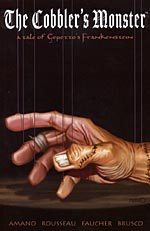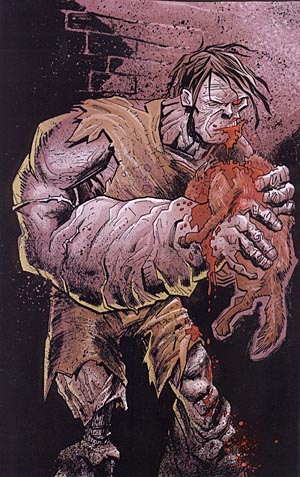 Written by Jeff Amano
Written by Jeff Amano
Penciled by Craig Rousseau
Inked by Wayne Faucher
128 pages, color
Published by Image Comics
The retelling of classic stories is something practiced in different sorts of media. Sometimes it’s a sequel, other times an adaptation, or perhaps inspired by something else. In the case of The Cobbler’s Monster, what we’re getting is two different stories merged together, and it’s a combination that I’m surprised we haven’t seen more of in the past.
It’s the late 19th century, and a monster walks the streets of New York City. When police go to the estate of Matthew Gregory, what they find is a tale of horror involving a father’s love for his dying son, and the lengths that one would go to save him. For Gepetto’s love has created something much more powerful than anyone would expect—and the strings are now broken as the cobbler’s monster begins its rampage.
The pairing of Pinocchio and Frankenstein makes such sense that it almost surprises me. They’re both classic stories about attempts to create life, but while the first is generally cheerful and upbeat, the latter is one of the great works of gothic horror. It’s the latter that Jeff Amano is clearly drawing his main inspiration here as we learn of Gepetto’s desire to find a way for the seriously ill Vincent to continue living. Much of The Cobbler’s Monster is a flashback as Gepetto and Matthew have to explain what they’d done, and it’s there that we really see the story as being a struggle for a father to save his son. That to me was the more interesting half of The Cobbler’s Monster, merging the need for companionship and love of a son from Pinocchio with the idea of Frankenstein about meddling with forces that were not supposed to be touched. Amano added in here the idea of the golem as well, using the Kabbalah as part of the equation. It’s an interesting twist on the idea, and while perhaps a bit unnecessary (how many ideas are getting thrown in here?) certainly provided for an interesting ending.
 The one problem is that while Gepetto and Vincent’s relationship is the intriguing part of the book for me, the non-flashback material felt a bit lifeless. Vincent-as-the-golem rampaging through New York never seemed to have any real drive to the material, almost an afterthought to the rest of the story. Even worse, when you hit the halfway point of the novel and the artificial “it’s all better now, it’s over” calm hits, it’s in some ways painful to read because you’ve still got half the book waiting to be read. At least in movies that sort of trick can be forgiven because your audience might have lost track of time, but here it falls flat. The book tries to pick up a bit for the conclusion (and substituting upstate New York for Frankenstein‘s Arctic locale is a clever choice), but aside from the very ending itself, once again the action sequences just don’t seem to work at all.
The one problem is that while Gepetto and Vincent’s relationship is the intriguing part of the book for me, the non-flashback material felt a bit lifeless. Vincent-as-the-golem rampaging through New York never seemed to have any real drive to the material, almost an afterthought to the rest of the story. Even worse, when you hit the halfway point of the novel and the artificial “it’s all better now, it’s over” calm hits, it’s in some ways painful to read because you’ve still got half the book waiting to be read. At least in movies that sort of trick can be forgiven because your audience might have lost track of time, but here it falls flat. The book tries to pick up a bit for the conclusion (and substituting upstate New York for Frankenstein‘s Arctic locale is a clever choice), but aside from the very ending itself, once again the action sequences just don’t seem to work at all.
Craig Rousseau and Wayne Faucher on the whole do a nice job with the art for The Cobbler’s Monster. Rousseau’s able to evoke the look of the 19th century in his art, his rough edges and craggy faces fitting in perfectly with Amano’s story. The golem’s hulking figure is able to inspire fear here thanks primarily to the art, with his misshapen body almost lurching across the page. Giulia Brusco’s colors work well with the drawings here, using a primarily-brown palette to present an almost earthy feel to the book. The one frustrating thing with the art is occasionally Rousseau’s style seemed a little too cartoonish for the purposes of the script. For example, the assault on the Order of the Shimmering Dawn should have been terrifying, but instead we get a full page splash page of one of the silliest exploding heads (complete with flying eyeball) that I can remember seeing in comics. What could have (and I can only assume should have) been gruesome and disturbing made me laugh out loud, and it ruined the moment. That sort of thing didn’t happen too often, but just often enough that it became more than a bit noticeable and distracting in its frequency.
The Cobbler’s Monster is the sort of book that in some ways isn’t quite the sum of its parts. There are a lot of really great ideas here. and lots of individual pieces work fantastically. Just like how the genesis of the book is two separate stories, The Cobbler’s Monster is almost two separate narratives that don’t quite converge. It’s by no means a failure, but in the end it’s frustrating because the book is so close to being great. I’d definitely check out future collaborations of this creative team, though. Whenever they did hit the mark, it was impressive indeed.
Purchase Links:
